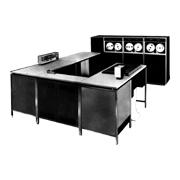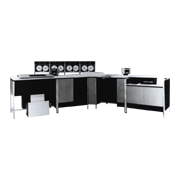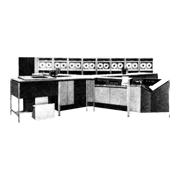The NEAC Series 2200 was based on the one-machine concept. It had the same uniform architecture throughout the lineup, from low-end to high-end models, and increasing data processing volume could be handled by shifting to a higher end model, so program assets could be inherited and reused. Five models -- the Model 100, 200, 300, 400 and 500-- were announced in May 1965. After that, the small Model 50 was added in August 1966, and the top-end Model 700 in November 1968.
The Model 100, 200, 300 and 400 employed wire memory and magnetic card memory, and the Model 500 used new technology, such as monolithic ICs in place of transistor circuits. Kana-COBOL was also used, and developed to suit the actual conditions in Japan at that time. Memory speed was high -- a maximum of 1.5 microseconds per 8 characters-- and the system had simultaneous processing capability for driving 16 peripheral devices. Across different models there was coupling of programs, central processing units and input/output devices as one machine, so it was possible to use one program interchangeably in any model. Compatibility extended not only between models; there was complete compatibility with the previous NEAC Series and IBM Series.
From the Model 100 to the Model 500, memory capacity covered a wide range from 2,048 characters to 524,288 characters, and a variety of peripheral devices were available, including magnetic tape units, magnetic drum units, high-capacity magnetic card memory units, magnetic ink character readers, optical character readers, data collectors and data stations. The machine was fully equipped with multiplexed program processing capability and an operating system, had remote terminal devices like data collectors and teller's machines, and, coupled with a magnetic card memory unit which was ideal for real-time processing, could function as a true online real-time system.
| 100 | 200 | 300 | 400 | 500 | |
|---|---|---|---|---|---|
| Announcement date |
May 1965 | ||||
| Memory capacity (Char) | Max. 32k | Max.65k | Max.131k | Max.262k | Max.524k |
| Memory speed (microseconds/ char) |
2 | 2 | 1.5 | 1 | 0.188 |
| Average instruction execution time | 91 micro- seconds |
44.5 micro- seconds |
29.5 micro- seconds |
20 micro- seconds |
5.7 micro- seconds |
| Simultaneous input/output operation | Max. 3 | Max.4 | 4 | Max.8 | Max.16 |
| Number of input/output trunks |
4 | Max.16 | 16 | Max.32 | Max.64 |
| Memory element | Core memory | ||||




